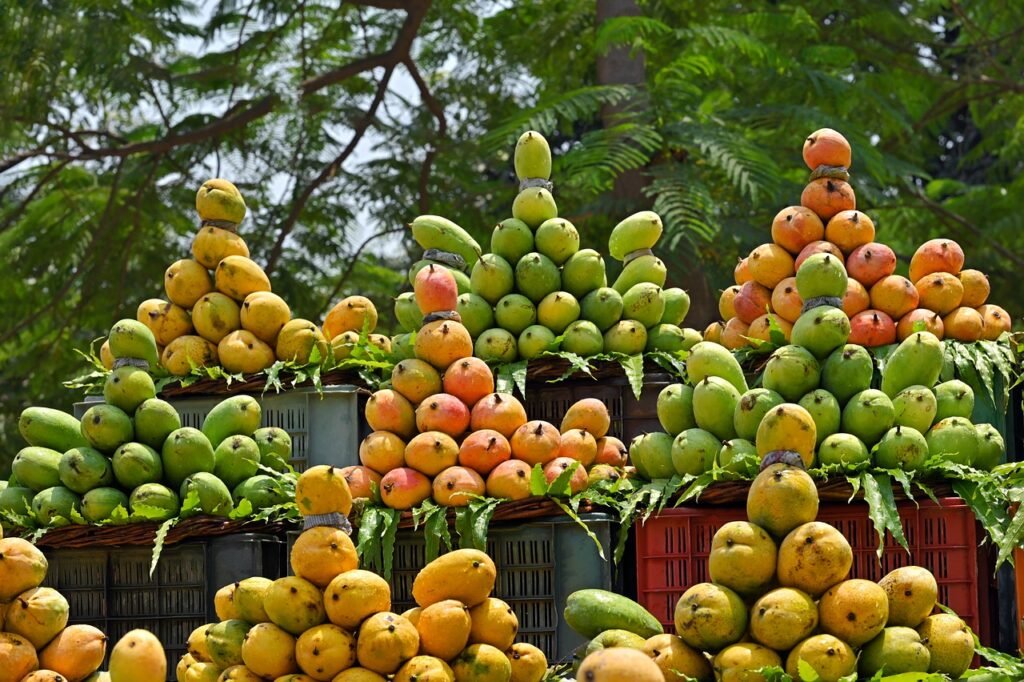Mangoes, the ‘king of fruits,’ are a delicious treat enjoyed worldwide. But with the advent of artificial ripening, discerning consumers are left wondering: how can we tell the real deal from the chemically ripened fruit?

In today’s fast-paced world, where demand for fresh produce is constant, some farmers and distributors turn to artificial ripening methods to speed up the process. One common technique is the use of calcium carbide, a chemical compound that releases acetylene gas, which mimics the natural ripening process. While this method can help mangoes ripen quickly and uniformly, it also poses health risks to consumers, as calcium carbide is a known carcinogen.
Here’s how to decipher the mango mystery and identify those that have been artificially ripened:
1. The Aroma Test:
Natural: A truly ripe mango emits a sweet, fruity aroma that’s intoxicating.
Artificial: A chemical-like, pungent smell signals artificial ripening. This may be accompanied by a subtle metallic or bitter odor.
2. The Color Check:
Natural: Mangoes ripen from green to yellow, often with a red or orange blush. The color should be even throughout the fruit.
Artificial: Ripened mangoes with an unnatural, intense yellow color, especially near the stem, are a red flag.
3. The Texture Touch:
Natural: Ripe mangoes have a slightly soft texture, yielding gently to pressure. They should feel firm but not hard.
Artificial: Mangoes that are excessively soft, mushy, or have a spongy texture might have been ripened prematurely.
4. The Stem Spot:
Natural: The stem spot on a naturally ripened mango should be slightly sunken and darkened.
Artificial: A stem spot that is dry, discolored, or unusually dark could indicate the use of chemicals.
5. The Inside Inspection:
Natural: The flesh of a naturally ripened mango should be soft, juicy, and fibrous. The seeds should be easily removable.
Artificial: Artificially ripened mangoes may have a dry, grainy texture, and the seeds might be difficult to separate.
Beyond the Clues:
Look for certifications: Some mangoes come with certifications that guarantee natural ripening.
Buy from reliable sources: Choose local markets or stores known for quality produce.
Additional Information:
Calcium carbide is a chemical compound that is commonly used in industries for various purposes. However, it is also used in some countries as a ripening agent for fruits such as mangoes, bananas, and apples. While this practice helps to accelerate the ripening process, it has been linked to several harmful effects on human health.
When fruits are treated with calcium carbide, they may absorb traces of the compound, which can be harmful when consumed. Some of the known harmful effects of calcium carbide on humans include:
- Cancer Risk:
Calcium carbide contains traces of arsenic and phosphorus, which are known carcinogens. Long-term consumption of fruits ripened with calcium carbide may increase the risk of developing cancer. - Respiratory Issues:
Inhaling calcium carbide dust or fumes can irritate the respiratory system, leading to symptoms such as coughing, wheezing, and shortness of breath. - Digestive Problems:
Consuming fruits treated with calcium carbide can lead to digestive issues such as indigestion, diarrhea, and stomach cramps. - Skin Irritation:
Direct contact with calcium carbide can cause skin irritation, redness, and itching.
Some of the common foods that are treated with calcium carbide include:
- Mangoes
- Bananas
- Apples
- Papayas
- Peaches
- Tomatoes
- How to Identify Fruits Ripened with Calcium Carbide:
It can be challenging to identify fruits that have been ripened with calcium carbide. However, there are some signs that you can look out for: - Unnatural uniform ripening
- Excessive softness
- Fruity smell but lack of flavor
- Uneven coloration
- Presence of powdery residue on the skin
To reduce the risk of consuming fruits ripened with calcium carbide, it is essential to take the following precautions:
- Purchase organic or locally grown fruits.
- Wash fruits thoroughly before consumption.
- Opt for fruits that are in season.
- Buy fruits with stems attached, as they are less likely to have been treated with calcium carbide.
While buying a perfectly ripe mango might seem like a simple task, the presence of artificial ripening methods requires vigilance. By being mindful of the aroma, color, texture, and other cues, you can ensure that your mango experience is both flavorful and safe. Remember, choosing naturally ripened fruits not only protects your health but also supports sustainable farming practices.
Below are a few simple tests to detect adulteration in everyday food items.

Adulteration, the intentional addition of inferior or harmful substances to food products, is a serious issue that can compromise consumer health and safety. While it can be difficult to detect adulteration in processed foods, there are certain simple tests that can be conducted at home to identify common adulterants in everyday foods.
1. Test for Turmeric in Milk
Materials:
Milk sample
Borax powder
Procedure:
Add a few drops of borax powder to a small sample of milk.
If the milk turns yellow, it indicates the presence of turmeric, which is often added to milk to give it a brighter yellow color.
2. Test for Dyes in Oils
Materials:
Oil sample
White filter paper
Procedure:
Dip the corner of a white filter paper into the oil sample.
If the filter paper turns a different color, it indicates the presence of dyes or other colorants.
3. Test for Sugar Syrup in Honey
Materials:
Honey sample
Glass of water
Procedure:
Drop a small amount of honey into a glass of water.
If the honey sinks to the bottom and remains in one place, it is pure. However, if it dissolves quickly or forms strands, it may contain sugar syrup.
4. Test for Water in Butter
Materials:
Butter sample
Frying pan
Procedure:
Heat a small amount of butter in a frying pan over low heat.
If water droplets form and splatter, it indicates the presence of added water.
5. Test for Starch in Milk
Materials:
Milk sample
Iodine solution
Procedure:
Add a few drops of iodine solution to a milk sample.
If the milk turns blue-black, it indicates the presence of starch, which can be added to thicken milk.
6. Test for Chalk Powder in Spices
Materials:
Spice sample
Vinegar
Procedure:
Add a small amount of vinegar to a spice sample.
If the vinegar bubbles or fizzes, it indicates the presence of chalk powder, which is sometimes used to bulk up spices.
7. Test for Artificial Ripening Agents in Fruit
Materials:
Fruit sample (e.g., banana, apple)
Potassium permanganate solution
Procedure:
Dip a thin slice of fruit into a solution of potassium permanganate.
If the fruit slice turns pink or red, it indicates the presence of artificial ripening agents.
Important Notes:
These tests are indicative but not definitive. If you suspect adulteration, it is recommended to consult a food safety expert or professional testing laboratory for confirmation.
Adulteration laws and regulations vary by country and jurisdiction. It is important to be aware of the specific regulations in your area.
Consuming adulterated food products can have serious health consequences. If you have any concerns, do not hesitate to report them to the appropriate authorities.
Source: Kindpng-Image
Also Read:
Qvive.in passionate about bringing you the most accurate and reliable information possible. Our dedication to honesty and transparency sets us apart – you can always trust that we’re delivering what is right and true. With a keen focus on social relevance, we aim to provide the most credible information available.
Join us in our mission to prioritize accuracy and reliability. Support Qvive.in by following us and spreading the word! Together, we can make a difference.
Stay informed. Stay empowered. Support Qvive.in.
